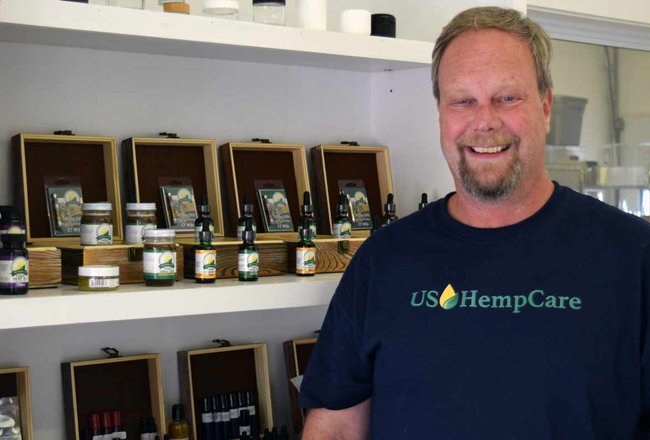
Last year, the federal farm bill ended a longtime prohibition against industrial hemp farms and gave states the right to apply for regulatory authority over local hemp farming. In May, Gov. Ned Lamont signed a bill into law that created a regulatory process to allow commercial hemp growing in Connecticut. Only three other states ”” Colorado, Oregon and Vermont ”” had passed laws enabling farmers to grow hemp under state supervision.
For this edition of Suite Talk, Business Journal Senior Enterprise Editor Phil Hall interviewed Jeff Wentzel, founder of the Connecticut Hemp Industry Association, to discuss the state”™s nascent hemp business environment. Wentzel is also CEO of US HempCare LLC, a Niantic-based producer of CBD products featuring cannabinoids and terpenes from organically grown hemp.
Where is Connecticut”™s hemp industry today?
“The legislation was passed a couple of months ago, so this is the first year that farmers are growing hemp. There are around 70 permits covering over 600 acres that have been approved by the Department of Agriculture, and the Department of Consumer Protection has approved several manufacturing permits.
“It”™s brand new and people are still learning. Thankfully, the hemp community is about people helping each other out. Farmers are creating co-ops to work together and pool their resources and equipment, so we have a great farming community in the state. Obviously, there are going to be some failures as well as successes in this first year. Most of the farmers we are working with are kind of dipping their toe in the water and taking it slow ”” maybe growing half an acre or an acre.”
So, you just cannot plant hemp seeds in your backyard? This requires state approval?
“That is correct. You have to apply through the Department of Agriculture. You have to put in the GPS coordinates where you are growing, and you need to get a background check and get fingerprinted. There are a couple of other hurdles in the application process: you need to show your sourcing with a certified seed or a seed that will be approved by the Department of Agriculture.
“The Department of Agriculture regulates everything until it leaves the farm ”” the cultivating, the growing and the processing. Once it leaves the farm, it is under the Department of Consumer Protection”™s regulatory framework for people who manufacture hemp consumables.”
Can Connecticut”™s soil and weather accommodate vibrant hemp crops?
“We”™ll see. I”™ve been growing it for the past couple of years. I started a hemp program at UConn and growing hemp in greenhouses and on a two-acre research farm. And we had great success with the two hemp varieties that we grew.
“We also partnered with a bunch of farms up in Maine last year and they have a shorter season, but they did really well. The Connecticut River Valley has some world-renowned soil and a unique microclimate, which is really special.
“It is a weed and it grows. Things like drying will be a challenge. I don”™t know if the farmers have enough space to dry their crops, which is a concern. With our climate, I think there is a lot of research that needs to be done in terms of pest management.”
The farming industry in Connecticut has gone through a rough economic patch in recent years. Do the state”™s farmers look to hemp as a potentially strong new revenue stream?
“I”™ve been speaking to a lot of the farmers. The dairy farmers were hit hard in recent years. The tobacco farmers have done OK, but the hay farmers aren”™t making a lot of money, and there are a lot of farms at risk right now. We”™re hoping this provides an opportunity to the next generation with profitable new crops.
“This doesn”™t just benefit farmers. We”™re looking to start up a whole new industry. It is farmers, manufacturers, packaging companies, and all the way down the supply chain to retailers and consumers.”
What role has the Connecticut Hemp Industry Association played in this environment?
“Up until a couple of months ago, it was a lobbying and advocacy mission. We worked hard to get the legislation done in our state. I was lucky to be part of a working group that was tasked by the governor to get the legislation done. It was my first experience at looking at the sausage-making side of it. It was a valuable experience in that we had a really formidable team. I know Connecticut gets a lot of criticism for not getting things done, and this was a real winner.
“As a lobbying and advocacy group, we were really just a Facebook page that connected farmers and got input from people to disseminate information from a legislative standpoint. We just got our website up and we”™re starting our membership campaign. “We”™ve had over 100 people express interest, but we haven”™t run their credit cards yet.”
Where does the industry stand on government regulatory oversight? Are you concerned the regulations could stifle growth and innovation?
“We support some regulation in the industry. We think we would benefit from some guardrails and set some minimum standards, and also enforcement on some of the bad actors out there. You read reports about CBD products that contain very little CBD or not what”™s advertised on the label.”
What is on your agenda for the next 12 months?
“We are going on a couple of tracks. Our board has established a couple of committees. The membership campaign is critical, but we”™re also starting to put together educational programming. There is still a lot of confusion out there about what hemp is and what it”™s not. We”™re going to do a series of farmer meetups with guest speakers, which will give us a chance for people to share knowledge and experiences.
“We”™re also looking at having the first state hemp conference later this year, which is long overdue. And there will be more lobbying and advocacy work.”























I work with the Eversource LED LIGHTING Program and wonder if there is an opportunity to look at the required lighting in green houses ?
Perhaps the farmers can benefit from this progrsm?
I am working on lighting for a greenhouse as I type… Do you have any insights on LED lighting and wavelengths. My biggest issue is lighting and water.